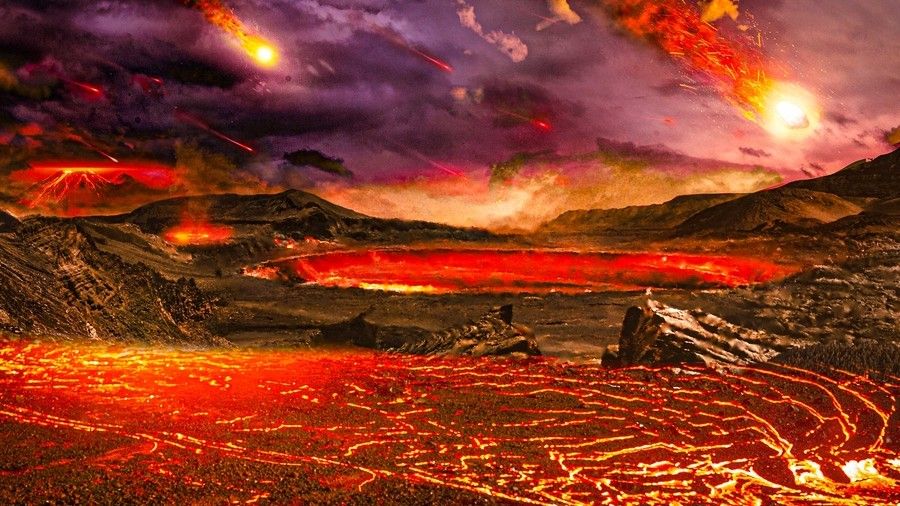Fragments of a hellish, lava-covered protoplanet that existed before Earth 4.5 billion years ago remain intact in ancient rock, a groundbreaking new study has revealed.
The findings, published Oct. 14 in the journal Nature Geoscience, show that these fragments contain distinct traces of potassium, which scientists have not seen in any other rocks or meteorites they have examined. In theory, these traces should have been destroyed in the huge impact that formed the moon, but it now appears that a small number of traces survived this catastrophe and have since stood the test of time.
you may like
Early Earth was a scorching ball of bubbling molten rock formed from cosmic dust and meteorites in the early solar system. But 100 million years later, our nascent planet was rocked by a devastating collision with a Mars-sized planet called Theia. The impact was so powerful that it completely scrambled the interior of the proto-Earth and blew away a chunk of Earth’s precursor that became the Moon.
Theia also brought vast amounts of new material to proto-Earth, irreversibly changing the chemistry of Earth’s precursors and turning Earth into a planet more similar to today. Over time, plate tectonics emerged, and material was repeatedly recycled into the Earth’s interior. As a result, scientists thought it would be impossible to find complete fragments of early Earth in modern rocks.
Researchers have previously found rocks with unusual chemical signatures related to the element ruthenium, which likely predates the moon-forming impact, but these features may have arisen after the impact as well, and are not hard evidence, Philip Carter, a computational planetary scientist and astrophysicist at the University of Bristol, UK, told Live Science.
Meanwhile, the newly discovered traces of potassium are the most definitive evidence yet that parts of early Earth still exist, added Carter, who was not involved in the study. “The most reasonable explanation is that this is material left over from before the impact,” he said.
Clues about potassium ratio
The newly discovered feature is a subtle imbalance in the proportions of different versions, or isotopes, of the element potassium compared to other materials on Earth. Potassium has three natural isotopes (potassium 39, potassium 40, and potassium 41), which have the same number of protons but different numbers of neutrons and therefore different atomic masses.
Potassium-39 and potassium-41 predominate in Earth’s rocks, with potassium-40 only occurring in trace amounts. In previous research, the authors of the new study found unusual amounts of potassium-40 in meteorites that record the changing conditions of the solar system over long periods of time. This suggested that isotopic anomalies in potassium could identify material that predates the formation of present-day Earth.
For the new study, Nee and her colleagues sampled ancient rocks from several locations where strange traces of ruthenium had previously been obtained, including outcrops in Greenland, Canada, and Hawaii. To find potential potassium isotope anomalies, the researchers ground the rock into powder and dissolved it in acid. They then separated the potassium in the sample and measured the ratios of different potassium isotopes using a mass spectrometer.
you may like
The researchers found that this rock is deficient in potassium-40 compared to other materials on Earth. To find out whether this potassium isotope anomaly could be traced back to early Earth, the research team conducted computer simulations. Using data from all known meteorites that have landed on Earth, they modeled the effects of these impacts and the effects of the Moon’s formation on Earth’s composition as new material was transported over time.
Simulations reveal that the collision with Theia in particular released large amounts of potassium-40 onto Earth, explaining the higher amounts of potassium-40 found in rocks today. “To change the overall character and overall isotopic composition of potassium in most rocks requires the addition of significant amounts of material,” Carter said. “Most of that change comes from the effects of moon formation itself. That’s the argument they use in their paper.”

The potassium signature found in the ancient rocks is different from what Nee and her colleagues previously found in meteorites, so it’s unlikely that meteorites created Earth’s current potassium profile after the moon-forming impacts. “This is actually saying that early Earth was formed from material that is isotopically different from any of the meteorites we have,” Carter said.
The moon-forming impact is the only known event that could have significantly increased the amount of potassium-40 in rocks on Earth, Carter said. This means the potassium-40-deficient rocks in Greenland, Canada and Hawaii are older than the moon-forming impacts and date back to early Earth, he said.
Martin Schiller, associate professor of geochemistry at the University of Copenhagen in Denmark, who was not involved in the study, agreed the results were convincing. “A truly surprising/novel observation is that the potassium isotope signature [in the ancient rocks] “It cannot be explained by a mixture of primitive meteorites,” he told Live Science via email.
The results suggest that remnants of early Earth survived geological processes such as the constant mixing of the mantle, the layer of Earth beneath the crust.
“This is a signature that has been preserved separately from the rest of Earth’s rocks for quite some time,” Carter said. And there is likely more of this proto-Earth material hidden at the base of the mantle, he said. “We’re just getting a fraction of what we come up with.”
Source link

